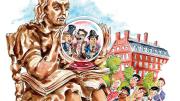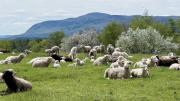Evidence is mounting for the metabolic firepower of brown fat, the energy-inefficient tissue that burns off calories as heat—as reported in this article on the work of Bruce Spiegelman from the Harvard Magazine archives.
Today's New England Journal of Medicine (accessible here for those with a subscription) carries three original articles on brown fat: one by Harvard Medical School researchers, and two others by researchers in the Netherlands, Finland and Sweden.
Scientists suspect that brown fat (unlike its sister tissue, white fat) may promote health by fending off obesity, and therefore we would be better off to have more of it. While infants have sizable brown-fat stores to keep them warm, the medical community had long thought that adult humans had little to none of the tissue type. With the advent of PET scanning, doctors stumbled on brown-fat deposits in adults quite by accident, noticing mysterious hotspots for glucose uptake in scans meant to search for tumors (which also burn through glucose at a rapid rate). Scientists then turned to efforts to find out just how much brown fat adult humans have; what causes the variation among adult humans; and what effect these brown-fat stores have. The studies published today examined evidence from biopsies and PET scans. (Read the New York Times account, with images from the papers, here.)
Women are apparently more likely than men to have significant amounts of brown fat: the Harvard researchers observed "substantial collections of brown adipose tissue" in the scans of 7.5 percent of female patients and 3.1 percent of male patients.
The team of scientists (led by instructor in medicine Aaron M. Cypess of the Joslin Diabetes Center) noted that these estimates should be considered "minimal estimates" for the percentage of the population with significant amounts of brown fat, because no action was taken to stimulate brown-fat activity (e.g., patients were not subjected to cold temperatures) before making the scans.
People may be able to beef up their brown-fat deposits by spending more time in cold environments ("Previous studies of biopsy specimens in northern Finland revealed more brown adipose tissue in outdoor workers than in indoor workers," the Harvard researchers noted). Indeed, the new study by Finnish and Swedish researchers found enhanced glucose uptake, as seen on scans, when the five subjects' feet were dunked in cold water, and the Dutch researchers found heightened brown-fat activity (as seen on a PET scan) in 23 of their 24 subjects (all of whom were men) when subjects were placed in a cold room (about 61 degrees Fahrenheit).
Although some studies have not found the same link, the papers published today found an inverse correlation between brown-fat mass or activity and body-mass index (in the Harvard study, obese or overweight subjects had less brown fat; in the Dutch study, brown fat responded less to cold temperatures in obese and overweight subjects).
Assuming this inverse relationship exists, it's not entirely clear yet what's cause and effect: are subjects thin because they have more brown fat, or is the extra brown fat somehow a product of being thin? The obese subjects in the Harvard study displayed a greater discrepancy between core temperature and skin temperature when exposed to cold. It's possible that different ways of responding to cold (generating heat vs. conserving it through constriction of blood vessels at the periphery) explain differences in body weight. But, Francesco Celi of the National Institute of Diabetes and Digestive and Kidney Diseases noted in an editorial on the three papers, it's also possible that the body adopts a different way of responding to cold because it is heavier: vasoconstriction is more effective at conserving heat in bodies with more white adipose tissue to insulate them.
The scientists whose work was detailed in the Harvard Magazine article (professor of medicine and professor of cell biology Bruce Spiegelman, associate professor of cell biology Pere Puigserver, and postdoctoral fellow Patrick Seale) were not directly involved with the studies published today, but the new papers reference their work. In 2008, Spiegelman and Seale published a paper showing that brown fat is more closely related to skeletal muscle than to white fat; also last year, the Dutch team had observed, in skeletal muscle, the same "uncoupling" of mitochondrial respiration from ATP production that gives brown fat its thermogenic power—suggesting that skeletal muscle, too, may function to heat the body and dissipate excess calories even while the body is at rest.
While many tantalizing questions still beckon, Celi writes, "Taken together, these studies point to a potential 'natural' intervention to stimulate energy expenditure: turn down the heat and burn calories (and reduce the carbon footprint in the process."
Celi notes that the body might foil this strategy with hunger, spurring people to compensate for the calorie expenditure by eating more. Nevertheless, he writes, the studies point to brown fat's potential value "as a target for interventions, pharmacologic and environmental, aimed at modulating energy expenditure."





